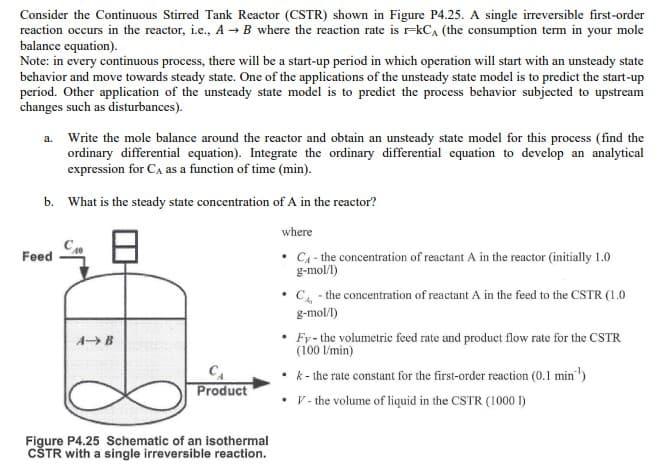Consider the Continuous Stirred Tank Reactor (CSTR) shown in Figure P4.25. A single irreversible first-order reaction occurs in the reactor, i.e., A B where the reaction rate is r-kCA (the consumption term in your mole balance equation). Note: in every continuous process, there will be a start-up period in which operation will start with an unsteady state behavior and move towards steady state. One of the applications of the unsteady state model is to predict the start-up period. Other application of the unsteady state model is to predict the process behavior subjected to upstream changes such as disturbances). a. Write the mole balance around the reactor and obtain an unsteady state model for this process (find the ordinary differential equation). Integrate the ordinary differential equation to develop an analytical expression for CA as a function of time (min). b. What is the steady state concentration of A in the reactor?
Consider the Continuous Stirred Tank Reactor (CSTR) shown in Figure P4.25. A single irreversible first-order reaction occurs in the reactor, i.e., A B where the reaction rate is r-kCA (the consumption term in your mole balance equation). Note: in every continuous process, there will be a start-up period in which operation will start with an unsteady state behavior and move towards steady state. One of the applications of the unsteady state model is to predict the start-up period. Other application of the unsteady state model is to predict the process behavior subjected to upstream changes such as disturbances). a. Write the mole balance around the reactor and obtain an unsteady state model for this process (find the ordinary differential equation). Integrate the ordinary differential equation to develop an analytical expression for CA as a function of time (min). b. What is the steady state concentration of A in the reactor?
Introduction to Chemical Engineering Thermodynamics
8th Edition
ISBN:9781259696527
Author:J.M. Smith Termodinamica en ingenieria quimica, Hendrick C Van Ness, Michael Abbott, Mark Swihart
Publisher:J.M. Smith Termodinamica en ingenieria quimica, Hendrick C Van Ness, Michael Abbott, Mark Swihart
Chapter1: Introduction
Section: Chapter Questions
Problem 1.1P
Related questions
Question
please solve all

Transcribed Image Text:Consider the Continuous Stirred Tank Reactor (CSTR) shown in Figure P4.25. A single irreversible first-order
reaction occurs in the reactor, i.e., A → B where the reaction rate is r-kCA (the consumption term in your mole
balance equation).
Note: in every continuous process, there will be a start-up period in which operation will start with an unsteady state
behavior and move towards steady state. One of the applications of the unsteady state model is to predict the start-up
period. Other application of the unsteady state model is to predict the process behavior subjected to upstream
changes such as disturbances).
a. Write the mole balance around the reactor and obtain an unsteady state model for this process (find the
ordinary differential equation). Integrate the ordinary differential equation to develop an analytical
expression for CA as a function of time (min).
b.
Feed
What is the steady state concentration of A in the reactor?
where
C₁ - the concentration of reactant A in the reactor (initially 1.0
g-mol/l)
A B
CA
Product
Figure P4.25 Schematic of an isothermal
CŠTR with a single irreversible reaction.
.
• C - the concentration of reactant A in the feed to the CSTR (1.0
g-mol/l)
• Fy- the volumetric feed rate and product flow rate for the CSTR
(100 l/min)
• k- the rate constant for the first-order reaction (0.1 min¹)
.
• V- the volume of liquid in the CSTR (1000 1)
Expert Solution
This question has been solved!
Explore an expertly crafted, step-by-step solution for a thorough understanding of key concepts.
Step by step
Solved in 4 steps with 1 images

Recommended textbooks for you

Introduction to Chemical Engineering Thermodynami…
Chemical Engineering
ISBN:
9781259696527
Author:
J.M. Smith Termodinamica en ingenieria quimica, Hendrick C Van Ness, Michael Abbott, Mark Swihart
Publisher:
McGraw-Hill Education

Elementary Principles of Chemical Processes, Bind…
Chemical Engineering
ISBN:
9781118431221
Author:
Richard M. Felder, Ronald W. Rousseau, Lisa G. Bullard
Publisher:
WILEY

Elements of Chemical Reaction Engineering (5th Ed…
Chemical Engineering
ISBN:
9780133887518
Author:
H. Scott Fogler
Publisher:
Prentice Hall

Introduction to Chemical Engineering Thermodynami…
Chemical Engineering
ISBN:
9781259696527
Author:
J.M. Smith Termodinamica en ingenieria quimica, Hendrick C Van Ness, Michael Abbott, Mark Swihart
Publisher:
McGraw-Hill Education

Elementary Principles of Chemical Processes, Bind…
Chemical Engineering
ISBN:
9781118431221
Author:
Richard M. Felder, Ronald W. Rousseau, Lisa G. Bullard
Publisher:
WILEY

Elements of Chemical Reaction Engineering (5th Ed…
Chemical Engineering
ISBN:
9780133887518
Author:
H. Scott Fogler
Publisher:
Prentice Hall


Industrial Plastics: Theory and Applications
Chemical Engineering
ISBN:
9781285061238
Author:
Lokensgard, Erik
Publisher:
Delmar Cengage Learning

Unit Operations of Chemical Engineering
Chemical Engineering
ISBN:
9780072848236
Author:
Warren McCabe, Julian C. Smith, Peter Harriott
Publisher:
McGraw-Hill Companies, The